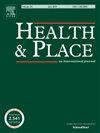Using citizen science to explore barriers and facilitators for healthy and sustainable lifestyles in office environments
IF 3.8
2区 医学
Q1 PUBLIC, ENVIRONMENTAL & OCCUPATIONAL HEALTH
引用次数: 0
Abstract
The socio ecological model states that individual behaviors at work are shaped by the interactions between individual employees and their work environments. This study used citizen science to gain insights into which elements of the built, social, and organizational environment in an office and surrounding neighborhoods in two Swedish cities were perceived as barriers to or facilitators of healthy and sustainable behaviors at work. Participants in the eight-week Sustainable Office Intervention pilot study (SOFIA) (n = 33) were cluster-randomized into an experimental arm (sustainable lifestyle) or a control intervention arm (healthy lifestyle). They used the Our Voice Healthy Neighborhood Discovery Tool mobile app to document contextual elements at their workplaces. In total, 114 photos and text-based narratives were recorded, and four themes emerged: built environment, building design, office ergonomics, and food and beverages. Eighteen percent of the photos were linked to pro-environmental behaviors, all exclusively captured by the experimental arm. Twelve barriers and solutions for improving the workplace environment were identified during discussions with participants in both arms. The findings provide insights for designing or renovating office spaces and urban planning to promote healthier and more sustainable lifestyles for office workers.
利用公民科学探索办公环境中健康和可持续生活方式的障碍和促进因素
社会生态模型指出,个人工作行为是由员工个人与其工作环境之间的相互作用形成的。本研究利用公民科学来深入了解在瑞典的两个城市中,办公室及周边社区的建筑、社会和组织环境中的哪些因素被认为是工作中健康和可持续行为的障碍,哪些因素被认为是工作中健康和可持续行为的促进因素。为期八周的可持续办公室干预试点研究(SOFIA)的参与者(n = 33)被分组随机分配到实验组(可持续生活方式)或对照干预组(健康生活方式)。他们使用 "我们的声音 "健康邻里发现工具移动应用程序记录工作场所的环境因素。共记录了 114 张照片和文字叙述,并形成了四个主题:建筑环境、建筑设计、办公室人体工程学以及食品和饮料。18%的照片与环保行为有关,这些照片全部由实验组拍摄。在与两组参与者的讨论中,发现了 12 个改善工作场所环境的障碍和解决方案。这些发现为办公空间的设计或改造以及城市规划提供了启示,以促进办公人员更健康、更可持续的生活方式。
本文章由计算机程序翻译,如有差异,请以英文原文为准。
求助全文
约1分钟内获得全文
求助全文
来源期刊

Health & Place
PUBLIC, ENVIRONMENTAL & OCCUPATIONAL HEALTH-
CiteScore
7.70
自引率
6.20%
发文量
176
审稿时长
29 days
期刊介绍:
he journal is an interdisciplinary journal dedicated to the study of all aspects of health and health care in which place or location matters.
 求助内容:
求助内容: 应助结果提醒方式:
应助结果提醒方式:


